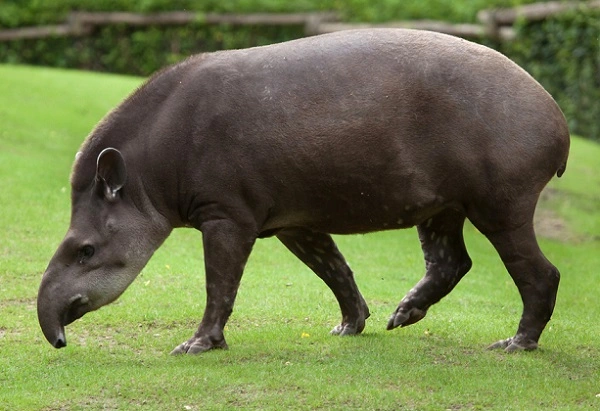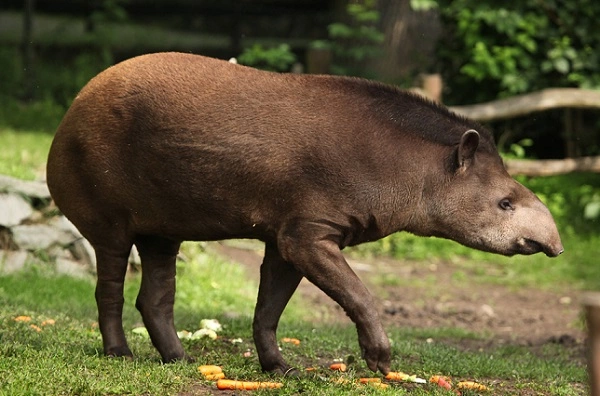Tapirs are interesting creatures that live in many different parts of the world. They have unique features that make them stand out from other animals, and they play an important role in their ecosystems. If you’re curious about tapirs, this post is for you! You’ll learn more about these animals and what makes them so special. Enjoy!

Tapir Description
The Tapir is a large, herbivorous mammal, similar in shape to a pig, with a short, prehensile snout. Tapirs are found in the tropical forests of South America, Central America, and Southeast Asia. They are the largest land mammals in their respective regions. Tapirs typically weigh between 250 and 700 pounds (113-317 kilograms). The Tapir has an array of adaptations that allow it to live successfully in its jungle home. These adaptations include its ability to swim; its wide, flexible snout, which is used to grasp leaves and fruits; and its four-toed hooves, which help it climb steep slopes. Tapirs are generally shy and solitary animals, but they will form small groups when feeding or wallowing in mud. The Tapir is an important animal in the rainforest ecosystem. It disperses seeds through its droppings, which helps to ensure the regeneration of the forest. Tapirs are hunted by humans for their meat and hide. However, they are also threatened by habitat loss due to deforestation.
Tapir Habitat
Tapirs are a diverse group of hoofed mammals that are characterized by their distinctive trunk-like noses. There are four species of tapir, all of which are found in the tropical forests of Central and South America, as well as Southeast Asia. Tapirs are shy and reclusive animals that spend most of their time hiding in the dense underbrush. They are solitary creatures that only come together to mate. Tapirs are good swimmers and often choose to live near water sources, such as rivers and lakes. Their diet consists mostly of leaves, fruits, and twigs. Tapirs are an important part of the ecosystem because they help to disperse seeds throughout the forest. Tapirs are threatened by habitat loss and hunting, and their populations are declining in many parts of the world.
Tapir Diet
Tapirs are herbivorous animals that live in forest and jungle habitats. Their diet consists mostly of leaves, fruits, and buds, but they will also eat small amounts of grasses, roots, and other vegetation. Tapirs use their prehensile upper lip to grasp branches and pull them down to their mouth. They also have a long proboscis-like nose that they use to sniff out food. Tapirs are generally solitary animals, but they will sometimes congregate around water sources or feeding areas. Tapirs are active during the day and night, but they spend most of their time foraging for food.

Tapir Size
Tapirs are large, ungulate mammals that are native to the Americas, Asia, and Africa. The four species of tapirs that are currently recognized by scientists are the Baird’s tapir, the kabomani tapir, the mountain tapir, and the Malayan tapir. Tapirs range in size from Baird’s tapir, which is the smallest species, weighing in at around 300 kilograms (660 pounds), to the kabomani tapir, which is the largest species, weighing in at around 400 kilograms (880 pounds). Tapirs are herbivores, and their diet consists primarily of leaves, fruits, and twigs. Tapirs have a lifespan of 20 to 30 years in the wild.
Tapir Lifespan
Tapirs are large, herbivorous animals that are native to Central and South America. They have distinctive round bodies, short necks, and long snouts, and they are often described as “living fossils” due to their similarity to ancient prehistoric creatures. Tapirs are generally shy and reclusive animals, but they can be fiercely territorial when it comes to their mating and feeding grounds. In the wild, tapirs typically live for around 20-30 years. However, this lifespan can be significantly reduced in captivity due to a lack of space and poor nutrition. Tapirs are an endangered species due to hunting and habitat loss, so it is important to do what we can to protect these fascinating creatures.
Tapir Behavior
Tapirs are large, herbivorous mammals that are native to the Americas. The Tapir is characterized by its distinctive trunk-like nose and short, stubby legs. Tapirs are shy and reclusive animals, and they are most active at night. Tapirs are very good swimmers, and they often seek refuge from predators in rivers and swamps. Tapirs are browsers, and they eat a variety of fruits, leaves, and stems. Tapirs have a keen sense of smell, and they use their noses to sniff out food. Tapirs are social animals, and they live in small herds. Tapirs communicate with each other through a variety of vocalizations, including grunts, squeaks, and whistles. Tapirs are hunted by humans for their meat and hides. Tapir populations are declining due to habitat loss and hunting pressure.
Tapir Speed
Tapirs are large, forest-dwelling animals that are closely related to horses and rhinoceroses. Tapirs are noted for their distinctive prehensile noses, or trunks, which they use to grasp leaves and fruits. Tapirs are found in tropical forests throughout Asia and South America. Tapirs range in size from the Mountain Tapir, which weighs up to 330 pounds, to the Baird’s Tapir, which can weigh up to 1,100 pounds. Despite their large size, tapirs are good swimmers and can run swiftly when necessary. When threatened, tapirs will often try to escape by running through the forest underbrush. Tapirs have been known to reach speeds of 35 miles per hour when running through dense forest vegetation. Tapirs are shy animals that are seldom seen by humans. For this reason, little is known about their behavior in the wild.Tapirs are nocturnal animals and spend most of their time alone, resting in thickets or wallowing in mud pits. Tapirs are solitary creatures except during mating season or when females are caring for their young. Females usually give birth to a single calf after a gestation period of 13 months. Young tapirs stay with their mothers for about two years.
Tapir Hunting
Tapir are large, herbivorous animals that inhabit tropical forests in South America, Central America, and Asia. Tapirs are endangered due to hunting and habitat loss. Tapirs are solitary animals that live in dense vegetation. They travel great distances to find food and water, and they use their snouts to communicate with other tapirs. Tapirs are excellent swimmers and can hold their breath for up to six minutes. Tapirs are generally shy and reclusive, but they can be dangerous when threatened. Tapirs have been known to attack humans who come too close to their young. Tapir meat is considered a delicacy in some parts of the world, but it is illegal to hunt tapirs in most countries due to their endangered status.
Conclusion
Tapir is an interesting animal that has many unique features. If you are looking for an animal to learn more about, tapir is a great option. They are not as well known as some of the other animals on this list, so you may be able to teach your friends and family something new about these creatures.
Frequently Asked Question


